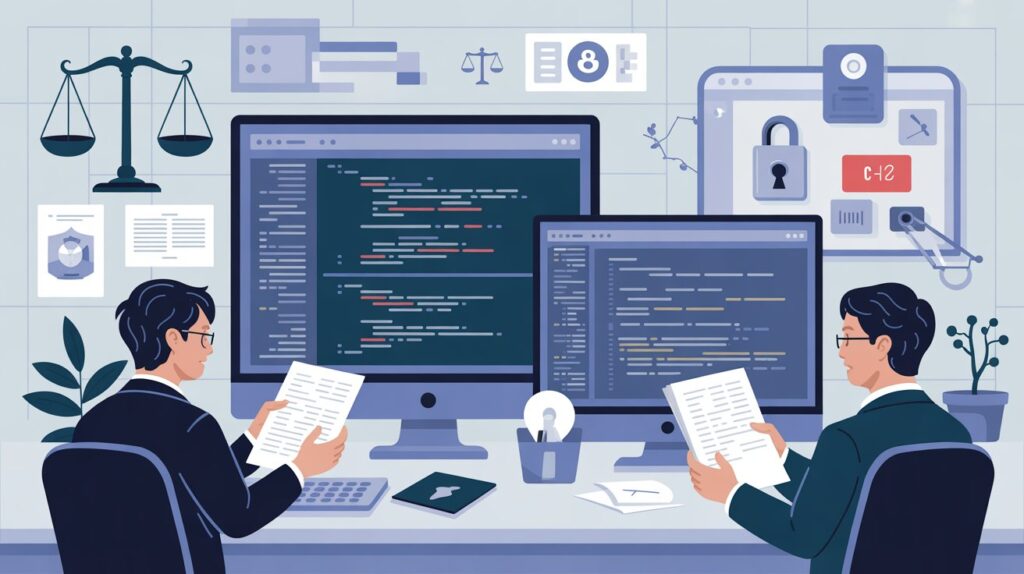Open-source software (OSS) has revolutionized how businesses build and deploy technology. It powers everything from mobile apps to enterprise infrastructure, enabling rapid innovation and cost efficiency. However, the open nature of this software also introduces unique challenges—particularly from a legal standpoint.
While open-source code is free to use, it isn’t free of obligations. Misunderstanding or ignoring the terms of open-source licenses can lead to intellectual property disputes, compliance failures, or even reputational damage. Understanding the legal risks of using open-source software is essential for every organization that integrates open-source components into its products or services.
This article explains the key legal risks, offers practical steps to manage them, and outlines how to build a sustainable, compliant open-source strategy that supports innovation while minimizing exposure.
What Is Open-Source Software?
Open-source software refers to code made available under a license that allows anyone to view, modify, and distribute it. Unlike proprietary software, open-source licenses encourage collaboration and transparency.
There are two major categories of open-source licenses:
-
Permissive Licenses — such as MIT, Apache 2.0, and BSD, which allow use, modification, and distribution with minimal restrictions (usually just attribution).
-
Copyleft Licenses — such as GNU General Public License (GPL) or Affero GPL (AGPL), which require derivative works or redistributed code to remain open-source under the same license.
While both models foster innovation, copyleft licenses, in particular, carry obligations that can impact commercial use. Without proper legal oversight, these obligations can create complex compliance issues for companies that integrate OSS into proprietary products.
Why Businesses Use Open-Source Software
Open-source software offers compelling advantages:
-
Cost Efficiency: Eliminates or reduces licensing fees.
-
Faster Development: Pre-built libraries accelerate time to market.
-
Community Support: Continuous updates and improvements from global contributors.
-
Flexibility: Developers can customize and optimize source code for specific needs.
However, these benefits come with responsibilities. Each open-source component carries its own license terms and conditions. Failure to follow them can create legal exposure—especially when software is redistributed or used in commercial products.
The Major Legal Risks of Using Open-Source Software
Understanding and managing the legal risks of using open-source software begins with recognizing where those risks come from. Below are the most common and serious legal challenges companies face.
1. License Non-Compliance
Each open-source project is governed by its own license, defining how the software can be used, modified, and shared. Failure to comply with these license terms can result in:
-
Forced disclosure of proprietary code: Copyleft licenses (like GPL) may require any derivative work to be released under the same open-source license.
-
Loss of distribution rights: Non-compliance may legally void permission to use or distribute the software.
-
Reputational harm and legal claims: Violating license terms could expose a company to public scrutiny or litigation.
Mitigation Strategy:
Maintain a comprehensive inventory of all open-source components and their licenses. Use software composition analysis (SCA) tools to track obligations and ensure compliance before deployment.
2. Intellectual Property (IP) Ownership Issues
One of the most complex legal challenges with OSS is uncertain ownership. Not all contributors to open-source projects formally assign rights to the project maintainers, which can create ambiguity about who owns the underlying code.
If your company integrates OSS into its product, and that code later becomes subject to a copyright or patent dispute, your organization could be drawn into costly litigation.
Mitigation Strategy:
Favor projects with clear governance structures and Contributor License Agreements (CLAs). Review contributor documentation to confirm that all contributors have granted proper rights to use and distribute their code.
3. Copyleft “Contamination” Risk
Copyleft licenses ensure that derivative works remain open-source. This is a noble goal but can cause commercial complications if proprietary and open-source code are combined improperly.
For example, incorporating GPL-licensed code into a proprietary software product may require the entire product to be released under the GPL, effectively making it open-source.
Mitigation Strategy:
Avoid mixing incompatible license types. Conduct a license compatibility review before combining OSS components with proprietary software. When in doubt, consult a software-licensing attorney.
4. Patent and Trademark Exposure
Certain open-source licenses include patent clauses, which grant users the right to use any patents held by the contributors. However, if contributors do not provide these rights—or later revoke them—users could face patent infringement claims.
Additionally, using OSS in ways that misuse project names or logos could infringe on trademarks.
Mitigation Strategy:
Check whether an open-source license includes an explicit patent grant (e.g., Apache 2.0). Avoid using open-source trademarks in your marketing or branding materials.
5. Lack of Warranty or Indemnity
Most open-source licenses explicitly disclaim all warranties and liabilities. If a defect in open-source code leads to system failure or security breaches, the maintainers are not legally responsible. The organization deploying the code bears full liability.
Mitigation Strategy:
Implement internal testing, validation, and security vetting for all OSS components. Include contractual protections when procuring commercial software that relies on open-source dependencies.
6. Security Vulnerabilities and Regulatory Risk
Security flaws in open-source software can lead to breaches that have legal implications, especially under privacy laws such as GDPR or HIPAA. A data breach caused by an unpatched open-source vulnerability could trigger regulatory investigations, fines, or class-action lawsuits.
Mitigation Strategy:
Combine legal oversight with technical controls. Establish policies for regular vulnerability scanning, patch management, and disclosure response. Document remediation efforts to demonstrate due diligence.
7. Supply Chain and Dependency Risks
Modern applications depend on thousands of open-source components and libraries. A vulnerability or license issue in a single dependency can cascade across your entire software stack.
Supply chain attacks—where malicious actors inject harmful code into open-source projects—can lead to serious operational and legal consequences.
Mitigation Strategy:
Use signed packages and maintain a verified internal repository of approved open-source components. Adopt Software Bill of Materials (SBOM) standards to track every dependency in your applications.
How to Manage and Mitigate Legal Risks
Managing open-source risk requires a blend of legal, technical, and organizational controls. Below are proven steps to establish a sustainable compliance framework.
1. Develop an Open-Source Governance Policy
An open-source policy defines how your organization evaluates, approves, and manages OSS use. It should include:
-
Criteria for license acceptance.
-
Approval workflows for new components.
-
Roles and responsibilities for legal, security, and development teams.
-
Documentation requirements for compliance audits.
This policy serves as the foundation for responsible OSS adoption.
2. Implement Software Composition Analysis (SCA) Tools
Automated SCA tools such as Black Duck, Snyk, or OWASP Dependency-Track can identify all open-source components in your codebase, flag license conflicts, and detect security vulnerabilities.
Integrating these tools into your CI/CD pipeline ensures continuous monitoring and immediate alerts when new risks arise.
3. Maintain a Centralized OSS Inventory
Keep an up-to-date catalog of all open-source components, versions, and licenses used across your organization. This “Software Bill of Materials” allows you to quickly respond to legal inquiries, license audits, or security incidents.
4. Conduct Regular License and Compliance Audits
Annual or semi-annual audits help detect outdated or improperly licensed components. Audits should verify that:
-
Each component has been approved under your governance policy.
-
License obligations (e.g., attribution) have been met.
-
Distribution packages include necessary license texts and notices.
5. Train Developers and Legal Teams
Compliance starts with awareness. Offer training to developers about license types, compatibility, and legal obligations. Similarly, educate your legal and procurement teams about OSS compliance processes so they can spot risks before they escalate.
6. Use Clear Contract Language with Vendors and Partners
If third-party vendors provide software that incorporates open-source components, ensure your contracts require:
-
Disclosure of all OSS used.
-
Confirmation of license compliance.
-
Indemnification for any open-source-related legal claims.
These clauses shift liability and ensure accountability throughout the supply chain.
7. Monitor for License Changes and Project Updates
Open-source projects evolve. A component’s license terms can change between versions, or new contributors might alter project ownership. Regularly review the status of critical dependencies to ensure continued compliance.
Real-World Example: GPL Violation Case
In one notable case, a major networking equipment manufacturer was found to have violated the GNU GPL by incorporating GPL-licensed code into its proprietary firmware without releasing the source code. The violation led to a settlement requiring the company to publish its modified source code and update its compliance processes.
This case illustrates how easily inadvertent non-compliance can lead to public and financial consequences—even for large, well-resourced companies.
Frequently Asked Questions (FAQs)
1. Is it safe to use open-source software in commercial products?
Yes, but it requires proper management. By adhering to license terms, maintaining a compliance policy, and conducting regular audits, businesses can safely leverage open-source benefits while avoiding legal pitfalls.
2. What’s the difference between permissive and copyleft licenses?
Permissive licenses (MIT, Apache 2.0) allow broad reuse with minimal restrictions. Copyleft licenses (GPL, AGPL) require derivative works to be distributed under the same license, potentially impacting proprietary code.
3. Can using open-source code force me to release my own code?
Only if you use copyleft-licensed code in a way that creates a derivative work. With proper architectural separation and license review, this can often be avoided.
4. How can I check if my open-source usage is compliant?
Use software composition analysis tools, maintain an OSS inventory, and conduct periodic license reviews to confirm compliance with all obligations.
5. Who should be responsible for OSS compliance in an organization?
Ideally, compliance involves collaboration between development, legal, and security teams. Larger organizations may also designate an “Open-Source Program Office” (OSPO) to oversee policies and approvals.
6. What happens if I violate an open-source license?
Violations can lead to legal notices, forced release of proprietary code, removal of distribution rights, or financial settlements. Early detection and cooperation with rights holders often mitigate damages.
Conclusion
Open-source software is an indispensable part of modern innovation, but its use comes with obligations. By understanding the legal risks of using open-source software, organizations can prevent compliance failures, safeguard intellectual property, and maintain the trust of their customers and partners.
Building a proactive OSS compliance program—supported by governance policies, automated tools, and cross-functional collaboration—allows companies to enjoy the advantages of open-source technology while minimizing legal exposure.
In a world where digital products are built on shared code, responsibility and transparency are not optional—they’re the foundation of sustainable innovation.












